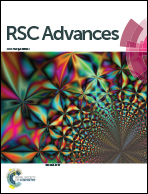Multi-wavelength excited white-emitting K2Gd(1−x)(PO4)(WO4):xDy3+ phosphors with satisfactory thermal properties for UV-LEDs
Abstract
A series of novel phosphate–tungstate phosphors, K2Gd(1−x)(PO4)(WO4):xDy3+ (0 ≤ x ≤ 0.07), were synthesized successfully via a conventional solid-state reaction method for the first time. XRD, GSAS Rietveld refinement, FT-IR, Raman, diffuse reflectance spectra, luminescent spectra, and thermal quenching were applied to investigate the phase, structure, luminescence and thermal stability properties. The results showed that the Dy3+-activated K2Gd(PO4)(WO4) phosphor could absorb wavelengths from the UV to the blue region, and emit blue (∼480 nm), yellow (∼570 nm) and red (∼650 nm) light from the f–f transitions of Dy3+ ions. The dominant energy transfer mechanism for Dy3+ ions was dipole–dipole interaction. An analysis of the thermal quenching indicated that the obtained phosphors have excellent thermal stability. As the temperature increased to 423 K (150 °C), the emission intensity of the KGPW:0.05Dy3+ phosphor with 388 nm excitation still retained about 76.8% of its initial intensity at room temperature. In addition, the color purity of K2Gd0.995(PO4)(WO4):0.005Dy3+ was calculated to be 90% with a correlated color temperature of 5569 K. Therefore, these results suggest that multi-wavelength excited K2Gd(1−x)(PO4)(WO4):xDy3+ phosphors may have potential to be candidates for white LEDs for lighting and optical display applications.



 Please wait while we load your content...
Please wait while we load your content...